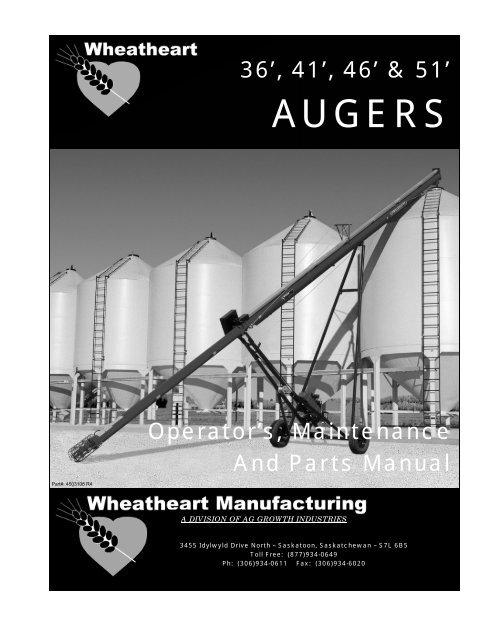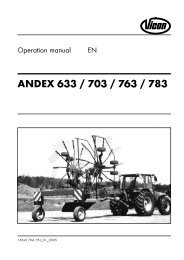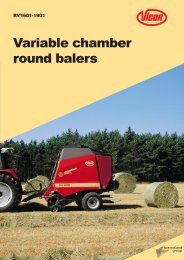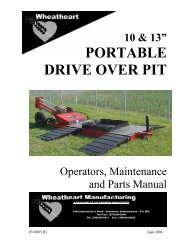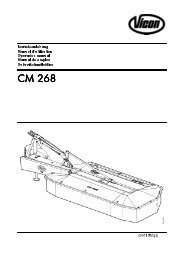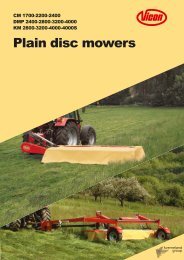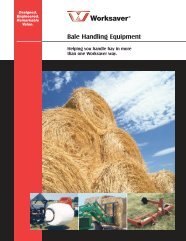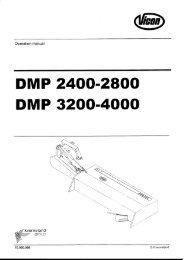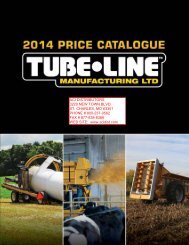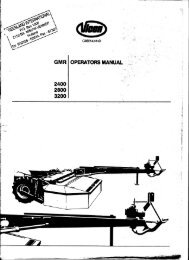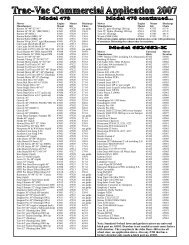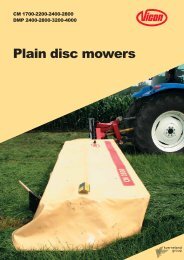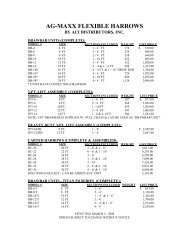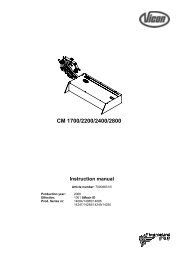BH Series Operators Manual
BH Series Operators Manual
BH Series Operators Manual
Create successful ePaper yourself
Turn your PDF publications into a flip-book with our unique Google optimized e-Paper software.
36’, 41’, 46’ & 51’<br />
AUGERS<br />
Part#: 4503106 R4<br />
Operator’s, Maintenance<br />
And Parts <strong>Manual</strong><br />
A DIVISION OF AG GROWTH INDUSTRIES<br />
3455 Idylwyld Drive North – Saskatoon, Saskatchewan – S7L 6B5<br />
Toll Free: (877)934-0649<br />
Ph: (306)934-0611 Fax: (306)934-6020
This Page Intentionally Left Blank
WARRANTY<br />
Wheatheart Manufacturing will repair or replace, free of charge, any part, or parts of the product<br />
that are defective in material or workmanship or both, provided that the product has been<br />
operated and maintained in accordance with the instructions in this manual. Transportation<br />
charges on parts submitted for repair or replacement under this warranty must be borne by the<br />
purchaser.<br />
This warranty is applicable to the original purchaser only and effective for the time periods and<br />
subject to the conditions provided for in this policy. This warranty is in lieu of any other warranty<br />
either expressed or implied, including that of fitness for a particular purpose. Wheatheart<br />
Manufacturing will not be liable for incidental or consequential loss or damage. This warranty<br />
gives you specific legal rights, and you may also have other rights provided by law in some<br />
areas.<br />
For warranty service contact your nearest Authorized Wheatheart Dealer.<br />
Warranty Period<br />
Private Farm Use<br />
Commercial, Custom, or Rental Use<br />
Replacement Parts<br />
One (1) Year from date of purchase<br />
Ninety (90) Days from date of purchase<br />
Ninety (90) Days from date of replacement<br />
Warranty Conditions<br />
This warranty does not cover damage that results from unauthorized alteration, accident,<br />
misuse, abuse, or failure to perform recommended normal maintenance; parts subject to normal<br />
wear; routine maintenance or adjustments; or normal deterioration of the exterior finish due to<br />
use or exposure.<br />
The warranty covers materials only, unless expenditures are pre-authorized in writing by<br />
Wheatheart Manufacturing.<br />
Defective parts are subject to inspection by a Wheatheart representative prior to approval of a<br />
warranty claim.<br />
All returned parts must be sent to the factory, freight pre-paid, in order to qualify for warranty<br />
replacement. Repaired or replaced parts will be returned freight collect.<br />
A Warranty Registration Form and Inspection Report must be completed at the time of delivery<br />
and returned to Wheatheart Manufacturing within thirty (30) days.<br />
iii
PRE-DELIVERY CHECKLIST<br />
MECHANICAL<br />
• All fasteners tightened<br />
• Belts present and adjusted to proper tension<br />
• Upper chain drive adjusted and lubricated<br />
• Auger rotates freely<br />
• Tire pressure within manufacturer’s specification<br />
• Wheel bolt torque within specification<br />
• Winch brake and locking mechanism tested, lock engages properly and brake prevents<br />
freewheeling. There should be at least 3 wraps of cable around winch drum in the fully<br />
down position.<br />
• Winch cable checked for damage, such as fraying, kinks, unraveling. Cable anchor on<br />
winch drum must be tight.<br />
• Gearbox oil level checked<br />
• Engine oil level checked<br />
• Machine greased<br />
• Machine cleaned<br />
SAFETY<br />
• All guards and shields installed, secured, and functional<br />
• All safety signs installed and legible<br />
• Reflectors installed and clean<br />
• Operating and safety instructions reviewed with owner<br />
• Operator’s <strong>Manual</strong> supplied to owner<br />
iv
DEAR VALUED CUSTOMER<br />
Congratulations on your purchase of a Wheatheart Auger. This piece of equipment will<br />
compliment your agricultural operation by aiding in the safe and efficient movement of grain,<br />
pulse crops, fertilizer, or any other granular materials.<br />
Your new Wheatheart Grain Auger will serve you well if you understand how it operates, if you<br />
use it properly, and if you care for it properly. This manual is intended to help you learn how to<br />
operate and maintain your equipment in a safe, efficient, and trouble-free manner. Please<br />
read this manual all the way through before you use your new Grain Auger.<br />
This Operator’s <strong>Manual</strong> covers all 8” augers built by Wheatheart Manufacturing so please use<br />
the Table of Contents as a guide when searching for specific information. Keep this manual in<br />
a safe place for future reference and for ordering replacement parts.<br />
Should any information remain unclear after thoroughly reviewing this manual, contact your<br />
Wheatheart Dealer for clarification before operating your auger. Knowing the serial number<br />
and date of purchase will save time in getting your questions answered. Please write down<br />
this information in the space provided below. The serial number plate is found on the auger<br />
tube near the gearbox toward the intake end.<br />
Manufactured by<br />
Wheatheart Mfg. Ltd.<br />
Saskatoon, Sask. Canada<br />
SERIAL NO.<br />
Made in Canada<br />
v
TABLE OF CONTENTS<br />
WARRANTY<br />
III<br />
DEAR VALUED CUSTOMER V<br />
TABLE OF CONTENTS VI<br />
1 SAFETY 1<br />
1.1 IMPORTANT SAFETY PRECAUTIONS 1<br />
1.2 SIGN-OFF FORM 4<br />
2 SAFETY SIGNS 5<br />
2.1 CARE & UPKEEP 5<br />
2.2 REPLACEMENT OF SAFETY SIGNS 5<br />
2.3 LOCATION OF SIGNS 5<br />
3 OPERATION 9<br />
3.1 DESCRIPTION OF THE EQUIPMENT 9<br />
3.2 OPERATOR RESPONSIBILITY 10<br />
3.3 OPERATOR CONTROLS 10<br />
3.4 BREAK-IN PERIOD 11<br />
3.5 PLACEMENT 12<br />
3.6 OPERATING INSTRUCTIONS 12<br />
3.6.1 Pre-Start Instructions 13<br />
3.6.2 Auger Drive and Lockout 14<br />
3.6.3 Starting With an Empty Tube 15<br />
3.6.4 Stopping 16<br />
3.6.5 Emergency Stop 17<br />
3.6.6 Restarting with a Full Tube 17<br />
3.6.7 Clean Out 17<br />
3.7 TRANSPORTING 18<br />
3.8 STORAGE 21<br />
4 MAINTENANCE 23<br />
4.1 FLUIDS AND LUBRICANTS 23<br />
4.1.1 Engine Oil 23<br />
4.1.2 Gear Oil 23<br />
4.1.3 Grease 24<br />
4.1.4 Storage and Handling 24<br />
4.2 MAINTENANCE INTERVALS 25<br />
4.3 MAINTENANCE PROCEDURES 26<br />
4.3.1 Visual Inspection 26<br />
4.3.2 Servicing Upper Chain Drive 27<br />
4.3.3 Greasing Machine 28<br />
4.3.4 Cleaning Machine 28<br />
4.3.5 Repacking Wheel Bearings 28<br />
4.3.6 Tightening Wheel Bolts 29<br />
4.3.7 Service Engine 29<br />
4.3.8 Checking Gear Box Oil Level 29<br />
4.3.9 Changing Gear Box Oil 29<br />
4.3.10 Truss Cable Service (52’ Auger only) 30<br />
4.3.11 PTO Driveline 30<br />
4.3.12 Winch 30<br />
4.3.13 Replacing Belts 31<br />
4.3.14 Tightening Belts 31<br />
5 SPECIFICATIONS 33<br />
vi
6 TROUBLESHOOTING 35<br />
7 SERVICE INFORMATION 37<br />
7.1 BOLT TORQUE 37<br />
7.1.1 Imperial Bolt Torque 37<br />
7.1.2 Metric Bolt Torque 37<br />
7.2 HYDRAULIC FITTING TORQUE 38<br />
7.2.1 Tightening Flare Type Tube Fittings 38<br />
7.2.2 Tightening “O” Ring Fittings 39<br />
8 PARTS LISTS 40<br />
WARRANTY REGISTRATION 50<br />
vii
This Page Intentionally Left Blank
1. Safety<br />
1.1 IMPORTANT SAFETY PRECAUTIONS<br />
WARNING<br />
BEFORE OPERATING THE EQUIPMENT<br />
• Read ALL instructions in the manual AND on the<br />
equipment.<br />
• Ensure you have received proper training in the<br />
safe use of this equipment.<br />
• Ensure everyone is clear of the machine.<br />
• Ensure all guards are in place.<br />
Failure to follow instructions exposes the operator<br />
and bystanders to possible serious injury or death.<br />
The operating and maintenance instructions contain safety information to:<br />
• Make you aware of the hazards associated with the machine,<br />
• inform you of the risk of injury associated with those hazards, and<br />
• tell you how to avoid or reduce the risk of injury.<br />
The safety-alert symbol points out important safety instructions, which if not followed, could<br />
endanger the personal safety of you and others. When you see this symbol – HEED ITS<br />
WARNING.<br />
Personal safety signs consist of the safety-alert symbol accompanied by one of three signal<br />
words – DANGER, WARNING, or CAUTION – and a safety message. The signal word<br />
indicates the likelihood and the potential severity of the identified hazard.<br />
DANGER Indicates an imminently hazardous situation that, if not<br />
avoided, will result in death or serious injury.<br />
WARNING<br />
Indicates a potentially hazardous situation that, if not<br />
avoided, could result in death or serious injury.<br />
CAUTION<br />
Indicates a potentially hazardous situation that, if not<br />
avoided, may result in minor or moderate injury.<br />
Equipment safety and instructional signs are composed of the signal words CAUTION and<br />
IMPORTANT, without the safety-alert symbol.<br />
CAUTION<br />
IMPORTANT<br />
Indicates a situation that, if not avoided, could result<br />
in damage to property or equipment.<br />
Indicates items relating to equipment performance,<br />
servicing, and care.<br />
1
S A F E T Y<br />
WARNING<br />
To reduce the risk of serious injury or death to persons using this equipment, follow these<br />
basic safety precautions.<br />
BEFORE OPERATING<br />
• Ensure guards are present and secure.<br />
• Clear the work area of unauthorized persons, particularly small children and pets.<br />
• Clean the work area to prevent slipping or tripping.<br />
• Ensure a fully equipped first aid kit is on hand and that you know how to use it.<br />
• Ensure a working fire extinguisher is on hand and that you know how to use it.<br />
• Be certain the PTO driveline is securely attached to the jackshaft and to the tractor<br />
• Before starting tractor, be certain that power to PTO is in the off position<br />
WHEN OPERATING<br />
• Keep hands, feet, hair, and clothing away from all moving or rotating parts.<br />
WHEN TRANSPORTING<br />
• Ensure tires are inflated to the tire manufacturer’s recommended pressure.<br />
• Check with local authorities regarding transportation of agricultural equipment on public<br />
roads. Obey all applicable laws and regulations.<br />
• Make sure that all lights and reflectors required by the local highway and transport<br />
authorities are in place, are functioning, and can be seen clearly by all overtaking and<br />
oncoming traffic.<br />
• Be sure the unit is hitched securely to the towing vehicle.<br />
• Do not allow riders while transporting.<br />
• Display a Slow Moving Vehicle emblem when transporting below 25 mph (40 km/h).<br />
• Use hazard-warning flashers when transporting with a tractor unless prohibited.<br />
• Keep to the right and yield the right-of-way to allow faster traffic to pass.<br />
• Never transport faster than the road terrain or conditions will allow you to do safely.<br />
• Use caution when making corners or meeting traffic.<br />
• Use caution when approaching height-limiting objects.<br />
• Take special care and precautions when transporting during times of limited visibility<br />
such as rain, snow, fog, dusk, or at night. It is recommended that you wait for a more<br />
appropriate time to move.<br />
• Use caution when turning or cornering.<br />
• Do not transport auger on a slope greater than 20 degrees. The auger may overturn.<br />
WHEN STORING<br />
• Store in an area away from human activity.<br />
• Do not permit children to play on or around the stored machine.<br />
WHEN PERFORMING ADJUSTMENTS, SERVICE, OR REPAIR<br />
• Shut off and disable the power source before working on the machine.<br />
• Ensure service area is clean and dry.<br />
• Ensure electrical outlets and tools are properly grounded.<br />
• Use proper tools for the job.<br />
• Ensure there is adequate lighting to perform the job safely.<br />
• Wear safety gear that is appropriate for the job being performed.<br />
• Use extra caution when cleaning and servicing augers because flighting edges can<br />
become sharp.<br />
• Follow proper procedures when mounting a tire on a rim. If in doubt, have a qualified tire<br />
repair service perform the required maintenance.<br />
• Install and secure all guards after maintenance work is completed.<br />
2
I M P O R T A N T S A F E T Y P R E C A U T I O N S<br />
Figure 1.1 Safety Work Area<br />
3
S A F E T Y<br />
1.2 SIGN - OFF FORM<br />
Wheatheart Manufacturing has designed this machine to meet or exceed the safety<br />
requirements established by the American Society of Agricultural Engineers (ASAE) and by<br />
the Occupational Safety and Health Administration (OSHA). The information presented in this<br />
manual is based on the requirements of these organizations. There may be other regulations<br />
applicable in your jurisdiction that you, as the operator, must familiarize yourself with and<br />
follow.<br />
Anyone who will be operating or maintaining the machine must read and understand ALL<br />
safety, operating, and maintenance information presented in this manual and must know and<br />
follow the local regulations applicable in the area of operation. DO NOT operate or allow<br />
anyone else to operate this equipment until such information has been reviewed and<br />
understood. REVIEW THIS INFORMATION ANNUALLY PRIOR TO THE SEASON START-<br />
UP. Make these periodic reviews of SAFETY and OPERATION a standard practice for all of<br />
your equipment.<br />
I have read and understood the information in this Operator’s <strong>Manual</strong> and in any applicable<br />
local regulations, and I have been trained in the safe operation and maintenance of the<br />
machine<br />
DATE<br />
NAME<br />
(Please Print)<br />
SIGNATURE<br />
4
2. Safety Signs<br />
2.1 CARE & UPKEEP<br />
√<br />
√<br />
√<br />
Keep all safety signs clean and legible.<br />
Replace safety signs that are missing or have become illegible.<br />
Affix the required safety signs to any replacement parts. The replacement parts must<br />
display the same safety sign as the original part.<br />
2.2 REPLACEMENT OF SAFETY SIGNS<br />
Replacement safety signs are available through your authorized Wheatheart dealer or direct<br />
from the factory. Install the signs according to the following procedure.<br />
1. Ensure the installation area is clean and dry.<br />
2. Ensure the temperature is above 50° F (10° C).<br />
3. Determine the exact placement of the decal before removing the backing paper.<br />
4. Remove the smallest portion of the split backing paper.<br />
5. Align the sign over the specified area and carefully press the small portion with the<br />
exposed sticky backing in place.<br />
6. Slowly peel back the remaining paper and carefully smooth the remaining portion of the<br />
sign in place.<br />
7. Small air pockets can be pierced with a pin and smoothed out using a piece of the backing<br />
paper.<br />
2.3 LOCATION OF SIGNS<br />
The following signs are affixed to your machine in the locations shown. Familiarize yourself<br />
with the location of these safety signs and their content. Understand the type of warning and<br />
the area, or function related to that area, which requires your SAFETY AWARENESS.<br />
5
6<br />
S A F E T Y S I G N S
L O C A T I O N O F S I G N S<br />
Amber Reflector<br />
Center Line of tube, rearward as<br />
possible & max. 16ft (5m) spacing.<br />
(Both Sides) - Where Applicable<br />
Red Reflector<br />
Outermost Extremities<br />
Amber Reflector<br />
Outermost Extremities<br />
REMEMBER: If Safety Signs have been damaged, removed, or become<br />
illegible, or if parts are replaced without safety signs, new signs must be<br />
applied. New safety signs are available from your authorized dealer.<br />
7
3. Operation<br />
3.1 DESCRIPTION OF THE EQUIPMENT<br />
The Wheatheart Auger is designed to efficiently handle grain, pulse crops or other granular<br />
materials. The Auger comes field ready and equipped with such features as reinforced, lowpitch<br />
flighting at the intake for high capacity and longer wear, a belt engaging lever that can be<br />
operated from either side and a frame design that allows for extra bottom reach for bin loadout<br />
applications.<br />
Many features incorporated into this machine are the result of suggestions made by customers<br />
like you. Read this manual carefully to learn how to operate the machine safely and how to<br />
adjust it to provide maximum efficiency. By following the operating instructions in conjunction<br />
with a good maintenance program, your auger will provide many years of trouble-free service.<br />
Discharge & Upper<br />
Chain Drive<br />
Shaft Guarding<br />
Cable Bridge<br />
Pulley Guarding<br />
Track<br />
Intake &<br />
Intake Guarding<br />
Cable Adjustment<br />
Winch<br />
Engine & Belt<br />
Engage Lever<br />
9
O P E R A T I O N<br />
3.2 OPERATOR RESPONSIBILITY<br />
WARNING<br />
BEFORE OPERATING THE EQUIPMENT<br />
• Read ALL instructions in the manual AND on<br />
the equipment.<br />
• Ensure you have received proper training in<br />
the safe use of this equipment.<br />
• Ensure everyone is clear of the machine.<br />
• Ensure all guards are in place.<br />
Failure to follow instructions exposes the operator<br />
and bystanders to possible serious injury or<br />
death.<br />
Safe operation and maintenance of the machine is the operator’s responsibility. EVERYONE<br />
operating this equipment must read, understand, and follow ALL safety precautions and<br />
recommended operating and maintenance procedures in the manual and on the machine. By<br />
following recommended procedures, a safe working environment is provided for the operator<br />
AND the people working around him. A person who has not read and understood all operating<br />
and safety instructions is not qualified to operate the machine.<br />
The operator must not attempt operation or maintenance of the machine without proper<br />
training. An untrained operator is not qualified to operate the machine and exposes himself<br />
and bystanders to possible serious injury or death. It is the owner’s responsibility to provide<br />
training for all operators before they start working with the machine, and at least annually<br />
thereafter.<br />
3.3 OPERATOR CONTROLS<br />
The belt engaging lever, winch and engine are located as shown in Figure 3.1. Please refer to<br />
engine manual for engine controls.<br />
Figure 3.1 Winch<br />
Belt Engaging Lever & Engine<br />
10
B R E A K - I N P E R I O D<br />
3.4 BREAK-IN PERIOD<br />
Your auger does not require an elaborate break-in. However, following a few simple tips<br />
during the first 1000 Bu of operation can add to the reliability and life of your machine. Please<br />
refer to Section 4.5 for proper operating instructions.<br />
If any unusual noises or vibrations are encountered, determine the source, shut the auger off,<br />
lock out the power source and adjust. If unsure of the problem or procedure contact your local<br />
Wheatheart dealer.<br />
Checklist.<br />
√ Refer to engine owner’s manual for engine break-in procedure.<br />
√<br />
√<br />
√<br />
Inspect the motor mounting bolts for tightness.<br />
Check the oil level in the gearbox by removing the filler plug. Make sure the gearbox is<br />
half full (center of cross shaft) and free of foreign objects.<br />
Inspect all belts for alignment, tightness and abnormal wear. Adjust or replace as required.<br />
See Section 4.3.11 or 4.3.12 for the correct procedure.<br />
√ Check the upper chain drive tension and alignment and if it has been greased. Adjust /<br />
grease as required. See Section 4.3.2 for the correct procedure.<br />
√<br />
√<br />
√<br />
Inspect components for damage and abnormal wear. Replace or repair as required.<br />
Check the wheel bolt torque prior to transporting the unit. See Section 4.3.6 for<br />
recommended torque values.<br />
Check that tires are inflated to the manufacturer’s recommended pressure prior to<br />
transporting the unit.<br />
Please refer to the regular maintenance schedule given in Section 4.2 for recommended<br />
service intervals after the break-in period.<br />
11
O P E R A T I O N<br />
3.5 PLACEMENT<br />
When placing the auger follow these guidelines:<br />
DANGER<br />
ELECTROCUTION HAZARD<br />
• This auger is not insulated<br />
• Keep auger away from overhead power lines<br />
and devices.<br />
• Electrocution can occur without direct contact<br />
• Fully lower auger before moving.<br />
FAILURE TO KEEP AWAY WILL RESULT IN<br />
SERIOUS INJURY OR DEATH<br />
• Check for power lines.<br />
• Always move an auger with a vehicle or mover,<br />
not by hand.<br />
• Place auger on a firm level surface.<br />
• Do not place anything under the wheels of the<br />
auger for added height.<br />
• Chock wheels before augering any products.<br />
• Keep children and unauthorized personnel away<br />
from the hazardous area surrounding the auger.<br />
• Check the surrounding area for obstructions that may damage the auger.<br />
• Never allow persons to stand under or ride on the auger.<br />
• When operating auger in the raised position, rest the discharge end on the bin<br />
roof, or tie it down to bin to prevent upending or wind upsetting auger. When<br />
operating auger in a free-standing position, anchor the intake end.<br />
12
O P E R A T I N G I N S T R U C T I O N S<br />
3.6 OPERATING INSTRUCTIONS<br />
3.6.1 PRE-START INSTRUCTIONS<br />
To reduce the risk of injury or death to persons using this equipment, follow basic<br />
safety precautions.<br />
BEFORE OPERATING<br />
WARNING<br />
• Ensure guards are present and secure.<br />
• Clear the work area of unauthorized persons, particularly small children and pets.<br />
• Clean the work area to prevent slipping or tripping.<br />
• Ensure a fully equipped first aid kit is on hand and that you know how to use it.<br />
• Ensure a working fire extinguisher is on hand and that you know how to use it.<br />
• PTO driveline is securely connected (where applicable)<br />
The following items should be checked before operating the machine EACH TIME.<br />
√ Service the machine per the maintenance schedule in Section 4.2.<br />
√<br />
√<br />
√<br />
√<br />
√<br />
√<br />
√<br />
√<br />
√<br />
Check that the gas cap is in place.<br />
Ensure all shields are in place and secure.<br />
Drive belts are not frayed or damaged<br />
Drive belts are properly adjusted and aligned<br />
Lift cable is not frayed or damaged.<br />
Cable clamp(s) are secured.<br />
Auger wheels are chocked.<br />
Discharge spout and intake area are free of obstructions.<br />
<strong>Operators</strong> are aware of safety precautions.<br />
13
O P E R A T I O N<br />
3.6.2 AUGER DRIVE AND LOCKOUT<br />
Correct operation of the Wheatheart auger requires pre inspection of the drive system,<br />
operator knowledge on how to shut down the system, and a general monitoring of the system<br />
during operation.<br />
Drive System - Gas Engine<br />
Before starting the motor, ensure that:<br />
1. The gas tank is properly closed.<br />
2. The belt release is disengaged so that the belts are released from motor pulley.<br />
3. The area surrounding auger is properly ventilated.<br />
4. Pulley shields are in place and secure.<br />
To reduce the risk of injury or death to persons using this equipment, follow basic<br />
safety precautions.<br />
WHEN REFUELING<br />
WARNING<br />
Shut down engine and allow to cool before refueling. Hot engine could seriously<br />
cause a fire and serious injury.<br />
Lockout - Gas Engine<br />
1. Shut down and lock out power source.<br />
2. For engines with a rope or crank start, remove the spark plug wire or the spark plug. For<br />
engines with an electric start, remove the ignition key, the spark plug wire, or the spark<br />
plug.<br />
Drive System - Electric Motor<br />
Before starting the motor, ensure that:<br />
1. The motor is properly grounded.<br />
2. The belt release is disengaged so that belts are released from motor pulley.<br />
3. Pulley shields are in place and secure.<br />
14
O P E R A T I N G I N S T R U C T I O N S<br />
Lockout - Electric Motor<br />
1. The electric motor should be equipped with a main power disconnect switch capable of<br />
being locked in the off position only. The switch should be in the locked position during<br />
shutdown or wherever maintenance is performed on the auger.<br />
2. If reset is required, disconnect all power before resetting motor.<br />
Drive System - PTO Driveline<br />
1. Ensure that the PTO driveline is securely attached to the tractor and jackshaft.<br />
2. Do not use PTO driveline without a rotating shield in good working order.<br />
3. Do not exceed the maximum operating angle of 15 degrees.<br />
4. Be sure that the PTO-drive on the tractor is in the off position before starting tractor.<br />
5. Stay clear of the PTO hazard area.<br />
Lockout - PTO Driveline<br />
1. Shut off engine.<br />
2. Remove ignition key from tractor.<br />
3. If step 2 is impossible, remove the PTO driveline from tractor.<br />
3.6.3 STARTING WITH AN EMPTY TUBE<br />
CAUTION<br />
POTENTIAL EQUIPMENT DAMAGE<br />
Foreign objects can damage the auger. Remove any obstructions<br />
from the intake and discharge areas before operating the unit.<br />
CAUTION<br />
POTENTIAL EQUIPMENT DAMAGE<br />
Always engage belts with engine idling. Engaging belts at high<br />
engine speed will result in premature belt wear<br />
15
O P E R A T I O N<br />
1. Disengage the belt engaging lever so the motor pulley is not under load.<br />
2. Start the engine and then engage the belt engaging lever with engine at idle. Note: The<br />
flighting RPM on auger equipped with electric motors is not adjustable.<br />
DANGER<br />
ROTATING AUGER HAZARD<br />
Contact with rotating flighting will result in amputation<br />
or sever laceration.<br />
• DO NOT operate with guards removed or modified.<br />
• Keep hands and feet away from rotating auger.<br />
• Tie up long hair and remove jewelry.<br />
• DO NOT wear loose-fitting clothing or items that<br />
could become caught.<br />
• Shut off and lock out the power source before<br />
unplugging or cleaning.<br />
3. Increase the engine speed to achieve the desired augering speed.<br />
4. If everything is operating normally, start running grain through the auger.<br />
3.6.4 STOPPING<br />
CAUTION<br />
POTENTIAL EQUIPMENT DAMAGE<br />
Prolonged operation of an empty auger will cause unnecessary<br />
wear.<br />
1. Near the end of the load, reduce the feed of grain a decrease auger speed where possible.<br />
2. Run auger until tube is empty.<br />
3. When auger is clear of grain, disengage belt and stop engine/motor, disengage PTO<br />
4. Shut down and lock out power source.<br />
16
O P E R A T I N G I N S T R U C T I O N S<br />
3.6.5 EMERGENCY STOP<br />
Although it is recommended that the machine be emptied before stopping, in an emergency<br />
situation:<br />
1. Stop or shut down the power source immediately.<br />
2. Stop the flow of material (if applicable).<br />
3. Correct the emergency before resuming work.<br />
WARNING - LOCKOUT ALL POWER BEFORE ATTEMPTING REPAIRS/REMOVING OBSTRUCTIONS<br />
3.6.6 RESTARTING WITH A FULL TUBE<br />
CAUTION<br />
POTENTIAL EQUIPMENT DAMAGE<br />
Always engage belts with engine idling. Engaging belts at high<br />
engine speed will result in premature belt wear<br />
The tube may be filled with material if the machine is shut down inadvertently or for an<br />
emergency. It is recommended that you restart with the following procedure:<br />
1. With the power source locked out, remove as much of the grain as possible from the tube<br />
and intake.<br />
2. Start the engine and run it at half speed. Slowly engage the belt until the auger is brought<br />
up to speed.<br />
3. Once the auger has been started, increase the engine speed to achieve the desired<br />
augering speed.<br />
3.6.7 CLEAN OUT<br />
1. Run the unit to clean out the majority of the grain.<br />
2. Disable power source.<br />
3. Clean grain from the auger and hopper.<br />
4. Unstrap hopper and dump into container.<br />
17
O P E R A T I O N<br />
3.7 TRANSPORTING<br />
DANGER<br />
ELECTROCUTION HAZARD<br />
• This auger is not insulated<br />
• Keep auger away from overhead power lines and<br />
devices.<br />
• Electrocution can occur without direct contact<br />
• Fully lower auger before moving.<br />
FAILURE TO KEEP AWAY WILL RESULT IN SERIOUS<br />
INJURY OR DEATH<br />
To reduce the risk of injury or death to persons using this equipment, follow basic safety<br />
precautions.<br />
WHEN TRANSPORTING<br />
WARNING<br />
• Ensure tires are inflated to the tire manufacturer’s recommended pressure.<br />
• Check with local authorities regarding transportation of agricultural equipment on public roads.<br />
Obey all applicable laws and regulations.<br />
• Make sure that all lights and reflectors required by the local highway and transport authorities<br />
are in place, are functioning, and can be seen clearly by all overtaking and oncoming traffic.<br />
• Be sure the unit is hitched securely to the towing vehicle.<br />
• Do not allow riders while transporting.<br />
• Display a Slow Moving Vehicle emblem when transporting below 25 mph (40 km/h).<br />
• Use hazard-warning flashers when transporting with a tractor unless prohibited.<br />
• Keep to the right and yield the right-of-way to allow faster traffic to pass.<br />
• Never transport faster than the road terrain or conditions will allow you to do safely.<br />
• Use caution when making corners or meeting traffic.<br />
• Be aware of height limiting objects.<br />
• Take special care and precautions when transporting during times of limited visibility such as<br />
rain, snow, fog, dusk, or at night. It is recommended that you wait for a more appropriate time<br />
to move.<br />
• Use caution when turning or cornering.<br />
• Do not transport auger on a slope greater than 20 degrees. The auger may overturn.<br />
• The winch must be in locked position. To lock, turn handle clockwise until two clicks are heard.<br />
CAUTION<br />
POTENTIAL EQUIPMENT DAMAGE<br />
Empty the auger before transporting. Transporting a full auger will place<br />
excessive loads on the tube assembly, frame, axle assembly, hitch, and towing<br />
unit.<br />
If auger wheels are partially or fully buried in snow or grain, do not attempt to<br />
move auger until snow or grain has been cleared away from auger wheels.<br />
18
The Wheatheart Auger is designed to be easily and conveniently readied for transport. Follow<br />
this procedure when converting the machine from operating to transport configuration.<br />
1. Make sure work area is clear.<br />
2. Connect the auger to the towing<br />
vehicle and use a retainer to lock<br />
the hitch draw pin in place.<br />
3. Belts are placed under tension for<br />
transport.<br />
T R A N S P O R T I N G<br />
4. Remove all wheel chocks.<br />
Figure 3.2 Auger in Transport Position<br />
5. Ensure auger is clear of any obstructions before lowering. Lower the auger fully until the<br />
roller track shoe is resting on the down position stop and there is slight tension on the lift<br />
cable. Refer to Figure 3.2.<br />
6. Place the PTO driveline in the transport saddle and secure (PTO drive only).<br />
WARNING<br />
PRIOR TO TRANSPORTING<br />
• Ensure auger is fully lowered.<br />
• Tension belts.<br />
• Install and secure the hitch pin retainer.<br />
• Install a safety chain between the towing vehicle frame<br />
and the auger hitch tongue.<br />
Failure to secure the unit prior to transporting could cause<br />
a serious hazard to the occupants of the towing vehicle or<br />
of other vehicles.<br />
7. Install the safety chain<br />
between the auger and the<br />
frame of the towing unit. The<br />
chain must have a load rating<br />
at least as high as the auger<br />
weight. The safety chain<br />
should be threaded through<br />
the handle on the lower tube<br />
and wrapped around auger<br />
tube before attaching to the<br />
towing vehicle. The loop<br />
should form a cradle that will<br />
prevent the auger from<br />
digging into the road surface<br />
Figure 3.3 Auger Chained to a Vehicle<br />
19
O P E R A T I O N<br />
and upsetting it, should a breakaway occur. Ensure there is no more slack in the chain<br />
than required for turning. When not in use store the safety chain in a clean dry place.<br />
Replace the safety chain if one or more links or end fittings are broken, stretched or<br />
otherwise damaged or deformed. Refer to Figure 3.3.<br />
The auger is now ready for road transport.<br />
WARNING<br />
MAXIMUM TRANSPORT SPEED<br />
DO NOT transport faster than 20 mph (32 km/h) or faster<br />
than road conditions allow.<br />
A weight imbalance between the towing vehicle and the<br />
machine could reduce your vehicle’s stability, handling,<br />
and braking ability and lead to an upset or collision.<br />
20
S T O R A G E<br />
3.8 STORAGE<br />
To reduce the risk of injury or death to persons using this equipment, follow basic<br />
safety precautions.<br />
WHEN STORING<br />
WARNING<br />
• Store in an area away from human activity.<br />
• Do not permit children to play on or around the stored machine.<br />
To ensure a long, trouble free life, the following procedure should be followed when preparing<br />
the unit for storage after the season’s use:<br />
1. Lower auger fully, with slight tension on the cable.<br />
2. Lockout all power.<br />
3. Remove all residual material from the auger.<br />
4. Remove entangled material from all moving or rotating parts.<br />
5. Wash the entire machine thoroughly using a water hose or pressure washer to remove all<br />
dirt, mud, debris or residue.<br />
6. Repair or replace any worn or damaged components to prevent any unnecessary<br />
downtime at the start of the next season.<br />
7. Inspect the engine for any abnormal leaks, check the air filter and clean or replace as<br />
necessary. Drain the gas from the carburetor and gas tank. Check to see that there is<br />
sufficient oil in the crankcase.<br />
8. Touch up all paint nicks and scratches to prevent rusting.<br />
9. Position the auger in an area that is dry, level, free of debris, and away from human<br />
activity.<br />
10. Support intake on blocks to eliminate prolonged contact with the ground.<br />
11. Lubricate all grease fittings per Procedure 4.3.3.<br />
21
O P E R A T I O N<br />
12. Check tire pressure and inflate to 24 psi (165 kPa).<br />
To reduce the risk of injury or death to persons using this equipment, follow basic<br />
safety precautions.<br />
WHEN HANDLING BATTERIES<br />
WARNING<br />
Exercise caution, batteries contain acid which can eat through clothing, burn skin<br />
and cause blindness<br />
13. Remove battery (where applicable) and store in a cool dry place.<br />
14. Cover engine to protect from the weather.<br />
15. Chock wheels.<br />
22
4. Maintenance<br />
The Wheatheart Auger has been designed and manufactured to meet the highest standards,<br />
while requiring minimal maintenance. Following a careful service and maintenance program<br />
will provide many years of trouble-free service.<br />
WARNING<br />
To reduce the risk of injury or death to persons using this equipment, follow basic<br />
safety precautions.<br />
WHEN PERFORMING ADJUSTMENTS, SERVICE, OR REPAIR<br />
• Shut off and lock out the power source before working on the auger.<br />
• Ensure service area is clean and dry.<br />
• Ensure electrical outlets and tools are properly grounded.<br />
• Use proper tools for the job.<br />
• Ensure there is adequate lighting to perform the job safely.<br />
• Wear safety gear that is appropriate for the job being performed.<br />
• Place chocks in front and behind the wheels to prevent the machine from rolling.<br />
• Use extra caution when cleaning and servicing augers because flighting edges can<br />
become sharp.<br />
• Follow proper procedures when mounting a tire on a rim. If in doubt, have a<br />
qualified tire repair service perform the required maintenance.<br />
• Install and secure all guards after maintenance work is completed.<br />
CAUTION<br />
DO NOT MODIFY THE EQUIPMENT<br />
Unauthorized modification may impair the function or safety of the<br />
equipment, could affect the life of the equipment, and will void your<br />
warranty.<br />
4.1 FLUIDS AND LUBRICANTS<br />
4.1.1 ENGINE OIL<br />
Refer to engine operator’s manual for recommended oil usage.<br />
4.1.2 GEAR OIL<br />
Use SAE approved 90W or equivalent gear oil.<br />
23
M A I N T E N A N C E<br />
4.1.3 GREASE<br />
Use SAE multi-purpose high temperature grease with extreme pressure (EP) performance or<br />
SAE multi-purpose lithium based grease.<br />
4.1.4 STORAGE AND HANDLING<br />
Always follow manufacturer’s guidelines for the safe and effective storage and handling of<br />
lubricants.<br />
Your machine can operate at top efficiency only if clean lubricants are used. Use clean<br />
containers to handle all lubricants. Store them in an area protected from dust, moisture and<br />
other contaminants.<br />
24
M A I N T E N A N C E I N T E R V A L S<br />
4.2 MAINTENANCE INTERVALS<br />
Refer to Section 4.3 Maintenance Procedures, for details of service.<br />
Time Period<br />
Maintenance<br />
Procedure<br />
Daily (8000) BU<br />
Periodically<br />
(40,000 Bu)<br />
Annually<br />
(Before Storage)<br />
Annually<br />
(After Storage)<br />
Visually Inspect the Unit 4.3.1<br />
√<br />
Check engine oil level 4.3.7<br />
√<br />
Service PTO Driveline 4.3.11<br />
√<br />
Check Air Filter 4.3.7<br />
√<br />
Service Upper Chain Drive 4.3.2<br />
√<br />
Service Belts 4.3.13<br />
√<br />
4.3.14<br />
Grease Machine 4.3.3<br />
√<br />
Check Gear Box Oil Level 4.3.8<br />
√<br />
Check Winch 4.3.12<br />
√<br />
Clean Machine 4.3.4<br />
√<br />
Service Engine 4.3.7<br />
√<br />
Repack Wheel Bearings 4.3.5<br />
√<br />
Tighten Wheel Bolts 4.3.6<br />
√<br />
Change Gear Box Oil 4.3.9<br />
√<br />
Service Truss Cables (51' only) 4.3.10<br />
√<br />
25
M A I N T E N A N C E<br />
4.3 MAINTENANCE PROCEDURES<br />
4.3.1 VISUAL INSPECTION<br />
When inspecting the machine be observant of possible defects in the machine.<br />
1. Be sure all guards are in place and not damaged<br />
2. Inspect auger shaft bushing for wear or discoloration.<br />
Refer to Figure 4.1.<br />
3. Examine flighting for damage or unusual wear.<br />
4. Check belt wear and alignment. Refer to Figure 4.2 for<br />
belt condition.<br />
5. Inspect the truss cables for tension and possible failure<br />
points (where applicable).<br />
Figure 4.1 Auger Bushing<br />
6. Inspect around the machine for evidence of oil leaks<br />
and/or fuel leaks.<br />
7. Examine tires for gashes, uneven wear, or loss of air<br />
pressure<br />
8. Be sure all safety decals are in place and legible.<br />
9. Inspect winch cable for fraying, kinks, unwinding, or<br />
other possible damage.<br />
10. Make sure the discharge spout and intake area are<br />
free of obstructions.<br />
Figure 4.2 Belt Condition<br />
11. Check that the PTO driveline is connected securely (where applicable).<br />
12. Ensure the intake housing fasteners are properly secured.<br />
26
M A I N T E N A N C E P R O C E D U R E S<br />
4.3.2 SERVICING UPPER CHAIN DRIVE<br />
DANGER<br />
ROTATING PART HAZARD<br />
Fingers, hands, feet, hair, clothing, or accessories can<br />
become caught or drawn into the pinch point.<br />
• Shut off and disable power source before adjusting<br />
or servicing.<br />
• DO NOT operate with guards removed or modified.<br />
• Keep fingers, hands, and feet away from rotating<br />
parts.<br />
• Tie up long hair and remove jewelry.<br />
• DO NOT wear loose-fitting clothing or items that<br />
could become caught.<br />
1. Lockout power.<br />
2. Remove cover plate from discharge end of auger.<br />
3. Check chain slack<br />
♦<br />
Chain slack is checked at the midpoint of the<br />
longest span. It should be no more than<br />
5/16” (8 mm). Refer to Figure 4.3.<br />
Figure 4.3 Upper<br />
Chain Drive<br />
CAUTION<br />
POTENTIAL EQUIPMENT DAMAGE<br />
Improper adjustment of chain will result in premature wear.<br />
3. Adjust the chain slack.<br />
♦<br />
♦<br />
Remove the connecting link from the chain.<br />
Remove a link from the chain, if the chain will not fit with one link removed add a<br />
half link to the chain and replace.<br />
4. Grease the chain with appropriate lubricant as per Section 4.1.<br />
27
M A I N T E N A N C E<br />
4.3.3 GREASING MACHINE<br />
IMPORTANT<br />
Original equipment bearings used by Wheatheart are sealed units<br />
and will not accept grease.<br />
1. Lockout all power.<br />
2. Grease points on the machine are shown in Figure 4.4.<br />
3. Use grease recommended in Section 4.1.3.<br />
4. Use only a hand-held grease gun.<br />
5. Wipe grease fitting with a clean cloth<br />
before greasing to avoid injecting dirt and<br />
grit.<br />
6. If a fitting will not take grease, remove and<br />
clean thoroughly. Also clean lubricant<br />
passageway. Replace fitting if<br />
necessary.<br />
Figure 4.4 Upper Chain Drive Zerk & Intake Zerk<br />
7. Replace and repair broken fittings immediately.<br />
4.3.4 CLEANING MACHINE<br />
1. Lockout all power.<br />
2. Clean out excess grain from auger tube and intake.<br />
3. Make sure nothing is obstructing the auger intake so water can run out.<br />
4. Wash the tube with a water hose or pressure washer until all dirt, mud, debris or residue is<br />
washed from the auger.<br />
5. Provide sufficient time for the water to drain from the auger.<br />
4.3.5 REPACKING WHEEL BEARINGS<br />
1. Block wheels and ensure unit is stable.<br />
2. Remove the wheel bolts and the wheels.<br />
3. Remove the wheel bearing and pack with grease. Refer to Section 4.1.3 for recommended<br />
grease.<br />
28
M A I N T E N A N C E P R O C E D U R E S<br />
4.3.6 TIGHTENING WHEEL BOLTS<br />
1. Tighten the wheel bolts with a torque wrench to 80 ft-lb (±10 ft-lb) of torque<br />
2. Tighten the wheel bolts in a diagonal pattern.<br />
4.3.7 SERVICE ENGINE<br />
1. See engine operator’s manual for service requirements.<br />
4.3.8 CHECKING GEAR BOX OIL LEVELS<br />
1. Lock out all power.<br />
2. Remove oil filler plug.<br />
3. Make sure the gearbox is half full (center of cross shaft) and free of foreign objects. Gear<br />
box should be level when checking gears.<br />
4.3.9 CHANGING GEAR BOX OIL<br />
1. Remove guards and gearbox from auger.<br />
2. Place a pan under the drain plug.<br />
3. Use a wrench and remove the drain plug.<br />
4. Loosen the filler plug so air can enter the<br />
gearbox and the oil will drain freely.<br />
5. Allow the oil to drain completely.<br />
6. Replace the drain plug.<br />
7. Add oil until the gearbox is half full (center of<br />
cross shaft) and replace filler plug. Gear box<br />
should be level when checking or refilling. DO NOT OVERFILL<br />
8. Reinstall gearbox and guards.<br />
Figure 4.5 Gearbox<br />
29
M A I N T E N A N C E<br />
4.3.10 TRUSS CABLE SERVICE (51’ AUGER ONLY)<br />
1. Locate the eyebolt anchors for the cable. Refer<br />
to Figure 4.6.<br />
2. Tighten the nut on the eyebolt until there is<br />
enough tension in the cable as to deflect the<br />
discharge end of the auger about 3” upward.<br />
3. If the proper cable tension can’t be obtained<br />
before the eyebolt runs out of adjustment then<br />
you should do the following:<br />
♦ Support auger tube.<br />
♦ Loosen the eyebolts but do not remove<br />
the nut.<br />
♦ Loosen the clamps on the cable on both<br />
sides.<br />
♦ Shorten the cable until there is tension on the cable and tighten the clamps.<br />
♦ Return to step 2.<br />
WARNING: Before doing anything to the trussing ensure auger tube is properly supported<br />
by overhead crane or other proper lifting device.<br />
4.3.11 PTO DRIVELINE<br />
1. Lock out all power.<br />
2. Check shield and replace if damaged<br />
3. Use grease recommended in Section 4.1.3.<br />
1. Service winch with auger in fully lowered position<br />
and cable slack.<br />
2. Check to make sure cable clamps are secure<br />
3. Keep a film of grease on gears. Occasionally oil<br />
the bushings, drumshaft and ratchet. Take care<br />
not to get oil or grease on brake discs.<br />
4. Inspect brake discs, replace if less than 1/16” thick.<br />
5. Oil cable pulley from time to time as needed.<br />
Figure 4.6 Cable Adjustment<br />
4. Lubricate both universal joints after every 8 hours of operation. Lubricate the center<br />
portion of the driveline (grease fitting is beneath shield) on a yearly basis (where<br />
4.3.12 WINCH<br />
30<br />
Figure 4.7 Cable Pulley
M A I N T E N A N C E P R O C E D U R E S<br />
4.3.13 REPLACING BELTS<br />
1. Lock out all power.<br />
2. Make sure that the belt engaging lever is disengaged.<br />
3. ON MOTOR DRIVE… Remove pulley shield at motor if necessary (belts may slip past<br />
pulley without removing shield). If belts do not come off easily the engine mounting bolts<br />
will have to be loosened and the engine pushed toward the intake end of the auger. ON<br />
PTO DRIVE… The PTO driveline and shield will need to be removed before the belts can<br />
be taken off the pulley.<br />
4. The new auger belts can now be put in place. Make sure to route the belt over the idler<br />
pulley.<br />
5. Follow Procedure 4.3.14 for the proper belt tension.<br />
4.3.14 TIGHTENING BELTS<br />
1. Lock out all power.<br />
2. Engage the belt engaging lever.<br />
3. Loosen the bolts on the engine mount shown in<br />
Figure 4.8.<br />
4. Slide the engine back (towards the spout) until<br />
there is adequate tension on the belt. If the<br />
alignment of the pulleys need adjustment slide the<br />
engine left or right until the pulleys line up<br />
5. Retighten the engine mount bolts and torque as<br />
per Service Information Table 7.1.<br />
Figure 4.8 Engine Mount Bolts<br />
6. Minor tension adjustments can be made by sliding<br />
the idler up or down. Idler shown in Figure 4.9.<br />
Figure 4.9 Belt Idler<br />
31
32<br />
This Page Intentionally Left Blank
5. Specifications<br />
IMPORTANT<br />
Wheatheart Manufacturing reserves the right to change specifications without notice.<br />
Auger Length 8 X 36' 8 X 41' 8 X 46' 8 X 51'<br />
Tube Size 8” (203mm) 8” (203mm) 8”(203mm) 8”(203mm)<br />
CAPACITIES<br />
Unloading Rate<br />
Up to<br />
3000 Bu / Hr<br />
(106m 3 /Hr)<br />
Up to<br />
3000 Bu / Hr<br />
(106m 3 /Hr)<br />
Up to<br />
3000 Bu / Hr<br />
(106m 3 /Hr)<br />
Up to<br />
3000 Bu / Hr<br />
(106m 3 /Hr)<br />
10 X 36’<br />
10” (254mm)<br />
Up to<br />
6000 Bu / Hr<br />
(212m 3 /Hr)<br />
DIMENSIONS<br />
Transport Length 36’ 5”(11.1m) 41’ 5”(12.6m) 46’ 4”(14.1m) 51’ 3”(15.6m)<br />
Width<br />
8’ (2.44m)<br />
Height 11’(3.35m) 10’ 9”(3.28m) 11’ 10”(3.6m) 12’ 10”(3.91m)<br />
Discharge Clearance Min 9’ 7”(2.92m) 9’ 6”(2.9m) 10’ 6”(3.2m) 11’ 6”(3.5m)<br />
Max 21’ 6”(6.55m) 24’ 8”(7.52m) 27’ 6”(8.38m) 30’ 8”(9.35m)<br />
TIRES<br />
Type<br />
15” Radial<br />
Inflation Pressure<br />
20 – 24 PSI (137-165kPa)<br />
WEIGHT<br />
Hitch Tongue Weight 66 LB(30kg) 68 LB(31kg) 72 LB(33kg) 70 LB(32kg)<br />
Total Weight<br />
1188LB(539kg) 1285LB(583kg) 1397 LB(634kg) 1540LB(699kg)<br />
POWER<br />
REQUIREMENTS<br />
Gas Engine 16 HP (12KW) 16 HP(12KW) 18 HP(13.5KW) 18 HP(13.5KW)<br />
Electric Motor<br />
PTO Drive<br />
5 - 7.5HP<br />
(3.75-5.6KW)<br />
5 - 7 1/2 HP<br />
(3.75-5.6KW)<br />
7 1/2 HP<br />
(5.6KW)<br />
540 RPM<br />
7 1/2 HP<br />
(5.6KW)<br />
PART<br />
SPECIFICATIONS<br />
Gas Tank Capacity 5 Imp Gal (22 L)<br />
Gear Box Oil Capacity 1/2 Imp Gal (2.3 L)<br />
Belt Size B210 B240 B270 B300<br />
36’5”(11.1)<br />
11’(3.35m)<br />
9’ 1”(2.77m)<br />
22’(6.71m)<br />
70 LB(32kg)<br />
1250LB(567kg)<br />
24 HP(18KW)<br />
10 HP<br />
(7.5 KW)<br />
B210<br />
33
34<br />
This Page Intentionally Left Blank
6. Troubleshooting<br />
The following table lists the causes and solutions to some potential problems you may<br />
encounter in operating your Portable Pit.<br />
PROBLEM CAUSED BY SOLUTION<br />
The auger<br />
does not turn.<br />
Auger is plugged or<br />
obstructed.<br />
Identify and remove obstruction.<br />
Drive belt is slipping.<br />
Adjust the tension of the belt.<br />
Fully engage the belt release.<br />
A bearing is seized.<br />
A chain is broke.<br />
Gearbox is seized.<br />
Identify the bearing and replace.<br />
Identify the chain and repair or replace.<br />
Fix or replace the gearbox.<br />
The bottom<br />
auger will not<br />
turn.<br />
Gearbox coupler bolt is<br />
broken or missing.<br />
Center coupler bolt is<br />
broken or missing.<br />
Replace the bolt.<br />
Replace the bolt.<br />
Auger is noisy. Obstruction in the auger. Identify and remove obstruction.<br />
Auger shaft bolts are<br />
loose or damaged.<br />
Auger shaft is bent.<br />
Flighting is damaged.<br />
Worn bearing.<br />
Low gear oil level.<br />
Upper chain drive loose.<br />
Tighten or replace bolts.<br />
Repair or replace auger.<br />
Repair or replace auger.<br />
Repair or replace bearing.<br />
Inspect the gearbox, replace if damaged<br />
or add oil if not damaged.<br />
Tighten the chain as required.<br />
35
T R O U B L E S H O O T I N G<br />
Troubleshooting Continued<br />
PROBLEM CAUSED BY SOLUTION<br />
The auger will<br />
not raise or<br />
lower.<br />
Auger is already at its<br />
max or min height.<br />
If at its maximum height lower the auger.<br />
If at its minimum height raise the auger.<br />
Broken cable.<br />
Obstruction in the slide.<br />
Winch is seized.<br />
Replace cable.<br />
Clear the obstruction.<br />
Consult your local Wheatheart dealer.<br />
Low material<br />
augering rate.<br />
The bottom or top of<br />
auger is obstructed.<br />
Clear the obstruction.<br />
Engine speed is too slow. Increase RPM of the engine.<br />
Inadequate material flow<br />
from truck or hopper.<br />
Flow into the auger<br />
intake is restricted.<br />
Material too wet or<br />
heavy.<br />
Flighting is worn.<br />
Increase flow of material.<br />
Clear grating of obstructions.<br />
Unloading rates are for dry grain.<br />
Repair or replace as required.<br />
Auger will not<br />
hold in<br />
elevated<br />
position.<br />
Tube is<br />
flexing.<br />
Belt slipping.<br />
Malfunctioning or<br />
damaged winch<br />
mechanism<br />
Loose truss cables.<br />
Identify the belt , adjust or replace as<br />
required.<br />
Consult your local Wheatheart dealer.<br />
Tighten cables as required.<br />
36
7. Service Information<br />
7.1 BOLT TORQUE<br />
7.1.1 IMPERIAL BOLT TORQUE<br />
Table 7.1 Imperial Bolt Torque<br />
SAE 2 SAE 5<br />
SAE 8<br />
BOLT (Nm) (lb-ft) (Nm) (lb-ft) (Nm) (lb-ft)<br />
DIAMETER<br />
¼” 8 6 12 9 17 12<br />
5/16” 13 10 25 19 36 27<br />
3/8” 27 20 45 33 63 45<br />
7/16” 41 30 72 53 100 75<br />
½” 61 45 110 80 155 115<br />
9/16” 95 60 155 115 220 165<br />
5/8” 128 95 215 160 305 220<br />
¾” 225 165 390 290 540 400<br />
7/8” 230 170 570 420 880 650<br />
1” 345 225 850 630 1320 970<br />
7.1.2 METRIC BOLT TORQUE<br />
Table 7.2 Metric Bolt Torque<br />
8.8<br />
10.9<br />
8.8<br />
10.9<br />
BOLT (Nm) (lb-ft) (Nm) (lb-ft)<br />
DIAMETER<br />
M3 0.5 0.4 1.8 1.3<br />
M4 3 2.2 4.5 3.3<br />
M5 6 4 9 7<br />
M6 10 7 15 11<br />
M8 25 18 35 26<br />
M10 50 37 70 52<br />
M12 90 66 125 92<br />
M14 140 103 200 148<br />
M16 225 166 310 229<br />
M20 435 321 610 450<br />
M24 750 553 1050 774<br />
M30 1495 1103 2100 1550<br />
M36 2600 1917 3675 2710<br />
37
S E R V I C E I N F O R M A T I O N<br />
7.2 HYDRAULIC FITTING TORQUE<br />
7.2.1 TIGHTENING FLARE TYPE TUBE FITTINGS<br />
1. Check flare and flare seat for defects that might cause leakage.<br />
2. Align tube with fitting before tightening.<br />
3. Lubricate connection and hand tighten swivel until snug.<br />
4. To prevent twisting the tube(s), use two wrenches. Place one wrench on the connector<br />
body and with the second tighten the swivel nut to the torque shown.<br />
TUBE SIZE<br />
OD<br />
(in.)<br />
NUT SIZE<br />
ACROSS FLATS<br />
(in.)<br />
Table 7.3 Flare Type Tube Fittings*<br />
TORQUE<br />
VALUES<br />
(N-m)<br />
TORQUE<br />
VALUES<br />
(lb-ft)<br />
# OF TURNS<br />
TO TIGHTEN<br />
(FLATS)<br />
(AFTER FINGER<br />
TIGHTENING)<br />
(TURN)<br />
3/16 7/16 8 6 1 1/6<br />
1/4 9/16 12 9 1 1/6<br />
5/16 5/8 16 12 1 1/6<br />
3/8 11/16 24 18 1 1/6<br />
1/2 7/8 46 34 1 1/6<br />
5/8 1 62 46 1 1/6<br />
3/4 1 1/4 102 75 3/4 1<br />
7/8 1 3/8 122 90 3/4 1<br />
* The torque values shown are based on lubricated connections as in reassemble<br />
38
H Y D R A U L I C F I T T I N G T O R Q U E<br />
TIGHTENING “O” RING FITTINGS<br />
1. Inspect “O” ring and seat for dirt or obvious defects.<br />
2. On the angle fittings, back the lock nut off until washer bottoms out at top of groove.<br />
3. Hand tighten fitting until back up washer or washer face (if straight fitting) bottoms on face<br />
and “O” ring is seated.<br />
4. Position angle fittings by unscrewing no more than one turn.<br />
5. Tighten straight fittings to torque shown.<br />
6. Tighten while holding body of fitting with a wrench.<br />
TUBE SIZE<br />
OD<br />
(in.)<br />
NUT SIZE<br />
ACROSS FLATS<br />
(in.)<br />
Table 7.4 “O” Ring Fittings*<br />
TORQUE<br />
VALUES<br />
(N-m)<br />
TORQUE<br />
VALUES<br />
(lb-ft)<br />
# OF TURNS<br />
TO TIGHTEN<br />
(FLATS)<br />
(AFTER FINGER<br />
TIGHTENING)<br />
(TURN)<br />
3/8 1/2 8 6 2 1/3<br />
7/16 9/16 12 9 2 1/3<br />
1/2 5/8 16 12 2 1/3<br />
9/16 11/16 24 18 2 1/3<br />
3/4 7/8 46 34 2 1/3<br />
7/8 1 62 46 1 1/2 1/4<br />
1 1/16 1 1/4 102 75 1 1/6<br />
1 3/16 1 3/8 122 90 1 1/6<br />
1 5/16 1 1/2 142 105 3/4 1/8<br />
1 5/8 1 7/8 190 140 3/4 1/8<br />
7/8 2 1/8 217 160 1/2 1/12<br />
* The torque values shown are based on lubricated connections as in reassemble<br />
39
PRODUCT:<br />
SERIAL NO:<br />
DELIVERY DATE:<br />
OWNER’S NAME:<br />
ADDRESS:<br />
WARRANTY REGISTRATION<br />
Wheatheart congratulates you on your new equipment purchase.<br />
The warranty Registration form must be filled out and sent to:<br />
Wheatheart Manufacturing<br />
3455 Idylwyld Dr. N., Saskatoon, Saskatchewan S7L 6B5<br />
within thirty (30) days from delivery date.<br />
NOTE – WARRANTY VOID IF NOT REGISTERED<br />
CUSTOMER COPY<br />
(Retain this card for warranty and record purposes)<br />
DEALER’S NAME:<br />
ADDRESS:<br />
PHONE NO:<br />
SIGNATURE:<br />
PHONE NO:<br />
PRODUCT:<br />
SERIAL NO:<br />
DELIVERY DATE:<br />
OWNER’S NAME:<br />
ADDRESS:<br />
PHONE NO:<br />
INVOICE NO:<br />
(Please refer to invoice # when filing claim)<br />
DEALER COPY<br />
(Retain this card for warranty and record purposes)<br />
DEALER’S NAME:<br />
ADDRESS:<br />
PHONE NO:<br />
SIGNATURE:<br />
INVOICE NO:<br />
(Please refer to invoice # when filing claim)<br />
WARRANTY REGISTRATION<br />
(Must be filled out and returned to Wheatheart within 30 days of delivery)<br />
OWNER’S NAME:<br />
DEALER’S NAME:<br />
ADDRESS:<br />
ADDRESS:<br />
PHONE NO:<br />
SIGNATURE:<br />
I acknowledge the product to be whole and in proper working order.<br />
PHONE NO<br />
SIGNATURE:<br />
I acknowledge the product to be whole and in proper working order. The<br />
owner has been given an Operator’s manual and has been versed on<br />
proper operation and maintenance.<br />
PRODUCT: SERIAL NO: DELIVERY DATE:<br />
INVOICE NO:<br />
GAS MOTOR SERIAL NO:<br />
50


